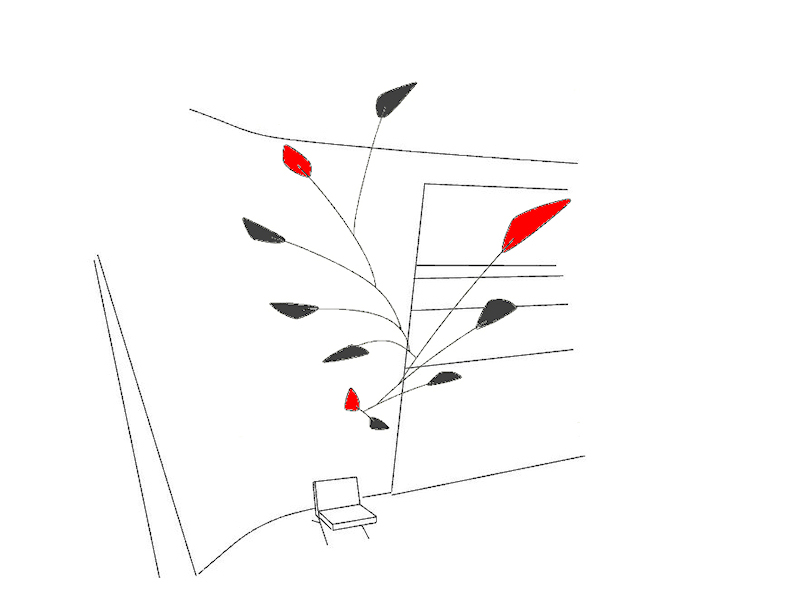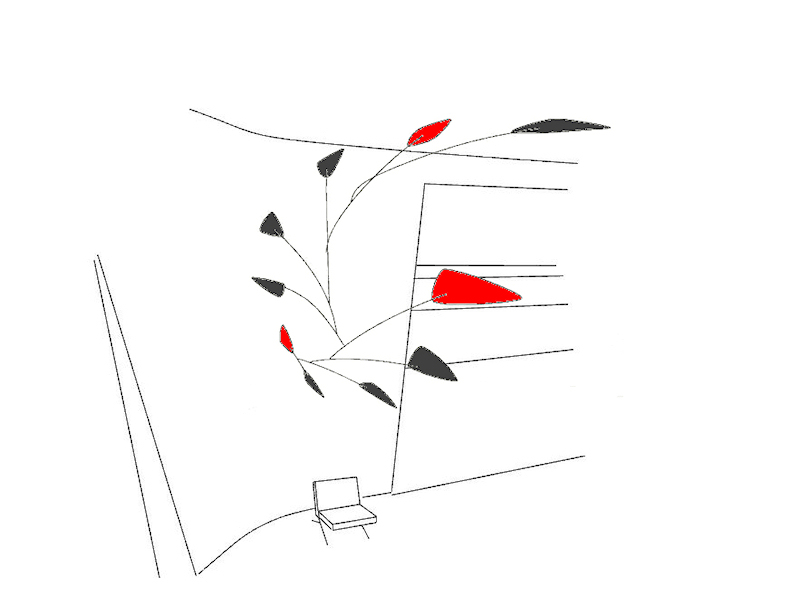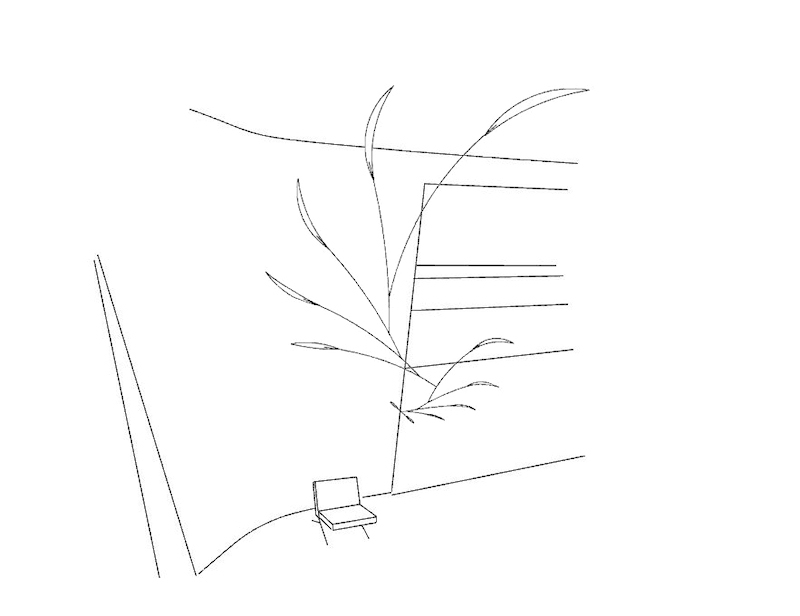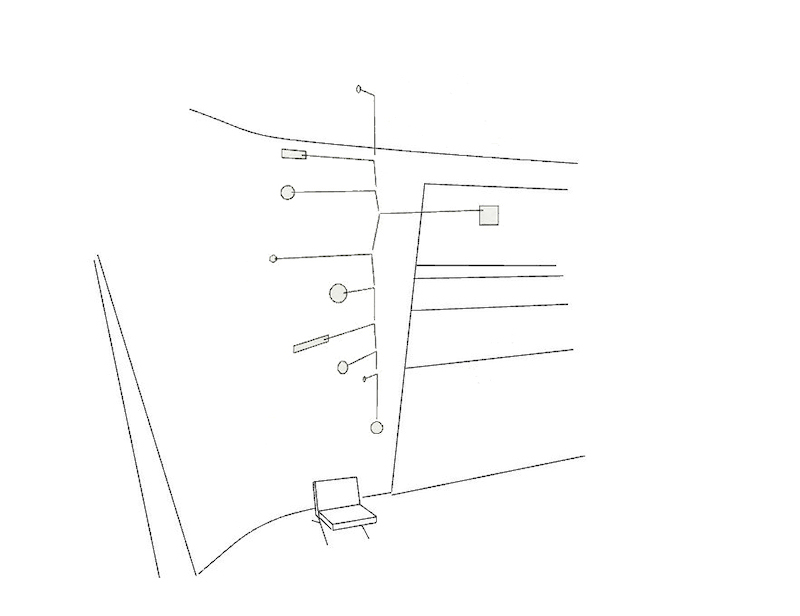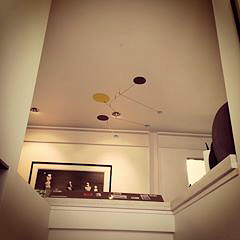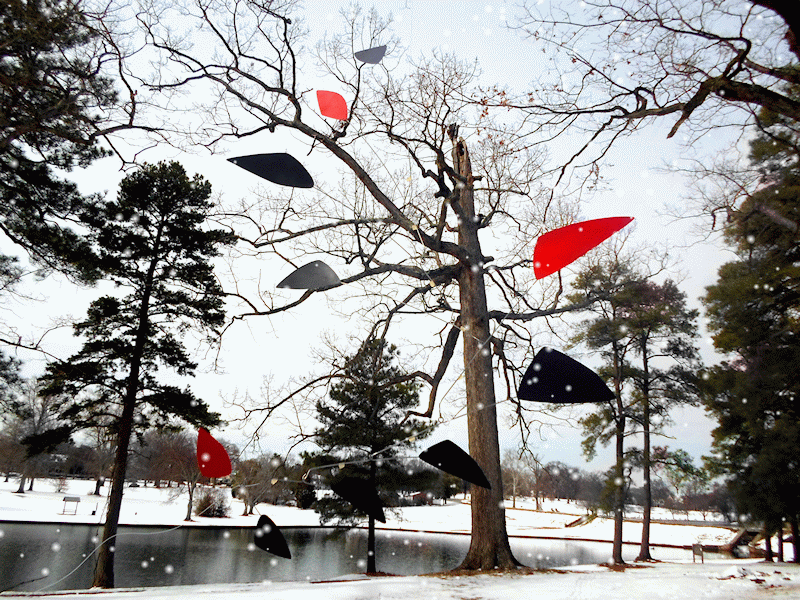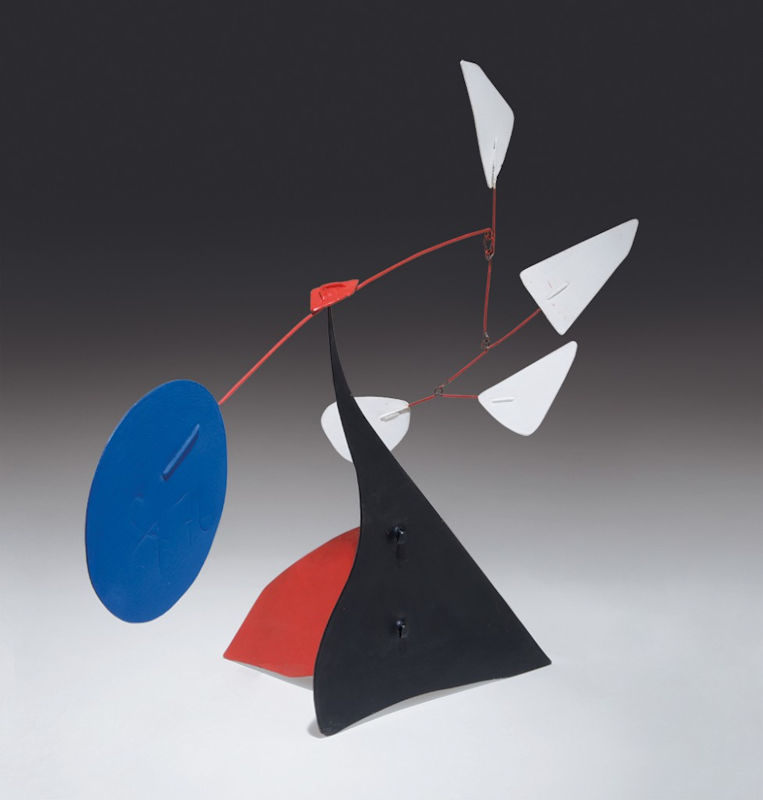Designs for large custom mobiles for a two story lobby
Designs for large custom mobiles for a two story lobby in Houston, TX – The client requested a Calder-style mobile that would help create a modern, classy, airy feeling:
Design 1:
In red and black, a classic Calder combination:
Again, in red and black:
Design 2:
First floor perspective:
Design 3 – inspired by the shapes on a rug that will be in the lobby:
Design 4 – Showing a different type of mobile structure with a mid-century modern art design element to it:
[Update: The client picked “Design 2” – see photos of the finished and installed mobile]
– Or see more of my other custom mobiles –
Mobile above stairwell – Two photos from a happy client
Two photos I just received from a happy customer (“Mobile is amazing, well crafted. Thank you!”):
Custom Mobiles for a sunglasses / eyeglasses company
Custom mobiles I designed for a sunglasses / eyeglasses company (Ray-Ban):
– Made of titanium which is 56% the weight of steel –
Read more of my blog or see more of my custom mobiles.
Where’s the Line between a Calder Replica and a Calder Inspired Mobile?
Every now and then I receive a request from a client to make a custom-designed Calderesque mobile, a mobile in the style of Alexander Calder, inventor of modern mobiles. I am not allowed, nor is anyone else, to make replicas (exact reproductions) of his mobiles. They are protected by copyright. I would refer you here to Manuel Marin (1942–2007) who was an artist and a convicted art forger. He admitted to making and selling millions of dollars of forgeries, mainly copies of works by Calder, and served prison sentences for his crimes.
Yet when I draw up proposals for these kinds of projects, I keep wondering where the lines are between a mobile that could be a replica, a mobile that’s strongly influenced by Calder’s style (“in the manner of Alexander Calder”), and a Calder inspired mobile. If I copied his style to a tee, most people wouldn’t be able to tell it from an original Calder mobile, yet it wouldn’t be a replica.
The question here is not simply about style, because Calder invented a new art form, and he still is to date by very far the most well known sculptor to create mobiles. This could be compared to Wassily Kandinsky, who is often (arguably) noted as having created the first abstract paintings starting in 1911, and then attributing all abstract paintings that followed by others to his work. An important difference here being that compared to abstract painting, few kinetic sculptors have tried to create their own style of mobiles so far, and even then, the basic idea, and in many cases the structures of their mobiles, are based on Calder’s work, and in that way, most mobiles are Calder inspired, even if they’re original in style. However, the underlying idea and structure of Calder’s mobiles was not invented by Calder. It is based on Man Ray‘s 1920 piece titled Obstruction, which he made about 10 years before Calder started to make mobiles. It utilizes the same structure as a whippletree mechanism, which probably dates back to between 190 to 209 AD. For further reading on this topic, please see the photos below of Calder’s copy of Man Ray’s sculpture, and see my page Mobiles before Calder – Who Invented Mobiles – A History of Mobiles.
From a legal perspective, case law is telling us that style isn’t protected by copyright. In Steinberg v. Columbia Pictures, the court stated that style is merely one ingredient of expression and for there to be infringement, there has to be substantial similarity between the original work and the new, purportedly infringing, work. In Dave Grossman Designs v. Bortin, the court said that:
“The law of copyright is clear that only specific expressions of an idea may be copyrighted, that other parties may copy that idea, but that other parties may not copy that specific expression of the idea or portions thereof. For example, Picasso may be entitled to a copyright on his portrait of three women painted in his Cubist motif. Any artist, however, may paint a picture of any subject in the Cubist motif, including a portrait of three women, and not violate Picasso’s copyright so long as the second artist does not substantially copy Picasso’s specific expression of his idea.”
For more on the legal perspective, there’s a great article by Greg Kanaan titled You Can’t Copyright Style.

The sculptor Jerome Kirk, who in his early career was strongly influenced by Calder, went to visit him at his studio around 1954, and described the encounter in his book: “Low on money and feeling the need for some encouragement, I visited Alexander Calder at his home in Roxbury, Connecticut. To enter his studio was like walking into a dream world. There were large work benches, vices, anvils and a magnificent clutter of tools, wire and sheet metal. His mobiles and stabiles of varying sizes were everywhere. At first Calder seemed interested in wanting to know what I was all about, but his cordiality gave way to petulance after seeing examples of my work. Guessing that he resented the close resemblance of my work to his own, I left discouraged, saddened and angry.” Jerome Kirk went on to creating his own very original style with his kinetic sculptures.
A standing mobile by Arthur Bauman:
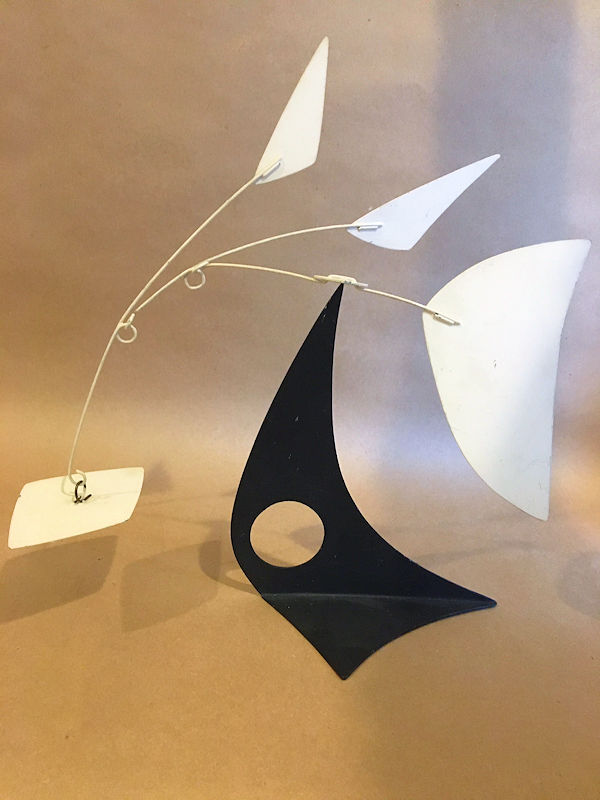
A standing mobile by Calder (Quatre Blancs, 1976):
Pablo Picasso once said: “What does it mean for a painter to paint in the manner of So-and-So or to actually imitate someone else? What’s wrong with that? On the contrary, it’s a good idea. You should constantly try to paint like someone else. But the thing is, you can’t! You would like to. You try. But it turns out to be a botch. And it’s at the very moment that you make a botch of it that you’re yourself.” (Hélène Parmelin, Picasso: The Artist and His Model, and other recent Works, 1965, page 43)
Picasso in his studio in 1956 standing next to a mobile not made by Calder:
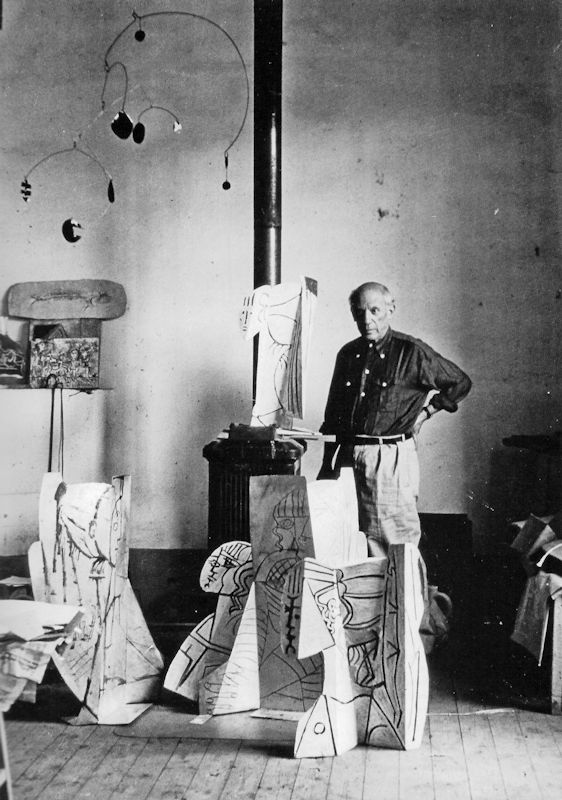
Here’s Calder (with Klaus Perls) at Calder’s 1956 exhibit at Perls Galleries with a copy (Untitled – Mobile with N Degrees of Freedom) that he made in 1946 of Man Ray’s sculpture titled Obstruction from 1920 suspended from the ceiling. It’s essentially the same sculpture just made with wire instead of coat hangers:
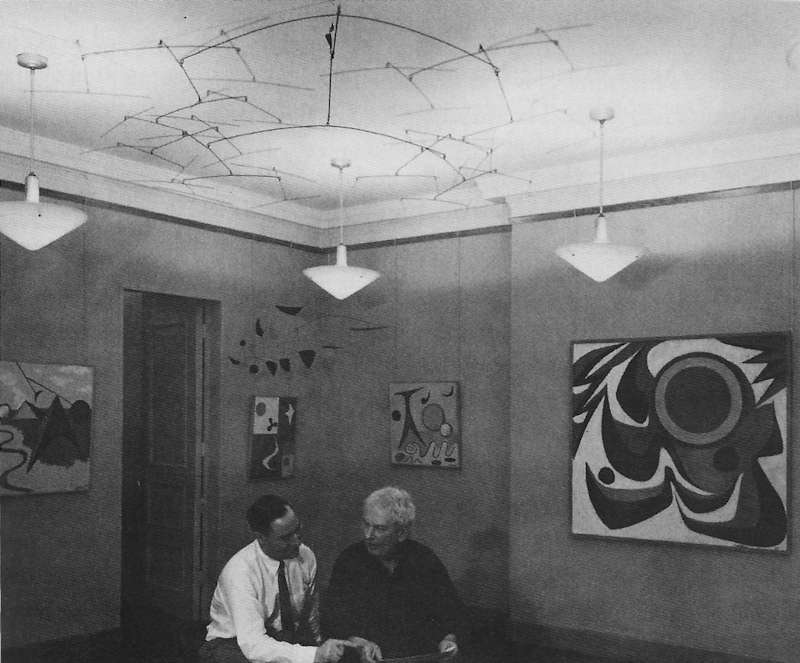
Man Ray’s Obstruction that he made in 1920:
On the topic of style, as in style in fine art and art movements, Calder is widely regarded as one of America’s most important surrealists, although he did not consider himself an abstract artist, as noted by Milly Burroughs. When pressed on this matter in an interview, Calder explained that his penchant for kinetic art and other-worldly forms was his interpretation of what the universe might look like, and would therefore be Realism.
– Read more of my blog posts about mobiles or see some of my mobile sculptures –


